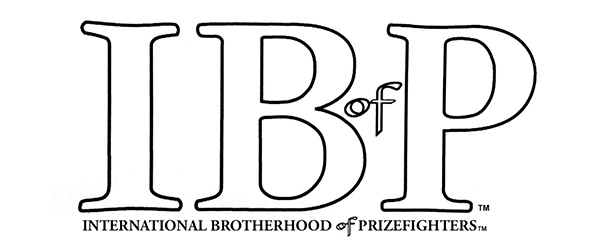Featured Articles
The Fifty Greatest Light-Heavyweights of All Time, Part 4 (No. 20-11)

Welcome to the jungle.
Although light-heavyweight surprised with its lack of depth in comparison to say, middleweight, the top twenty is monstrous. The fighters listed between twenty and eleven, in contrast with say, heavyweight, are a monumental threat to the fighters that make up the top ten. What separates the penultimate instalment from the ultimate isn’t necessarily quality of the light-heavyweight but the quality of the light-heavyweight that the fighter defeated, the length of time they spent in the division, or their level of dominance.
At #20 is a fighter who gave Harry Greb some of his toughest fights. At #18 is a stylistic foil so tricky that greater fighters may have succumbed to his deadly counterpunching stylistics; #17 and #16 between them, possibly, could defeat every fighter who will make up the top ten, the first slashing the rhythm of the very best boxers, the second surviving to out-point the deadly punchers. At #13 is a fighter that some people identify as something called the all-time head-to-head pound-for-pound greatest-of-all-time.
You get the point. These are some good fighters.
I hope you enjoy what I have written about them.
#20 – KID NORFOLK (83-23-6; Newspaper Decisions 28-4)
Kid Norfolk (born William Ward) made some decent money in fights in New York in 1921 and just handed it off to a charity that seems to have supported Irish children who didn’t have enough to eat. Four months later he found himself in Pittsburgh ring with the legendary and deadly Harry Greb landing, in the third, a booming right hand that left Greb neatly (if momentarily) deposited on the canvas. Norfolk got the better of the first five rounds of their ten rounder before Greb, being Greb, found his way back, generally being seen as having beaten Kid.
Norfolk and Greb were the same type of man. It was inevitable that they would meet again and when they did in 1924, Norfolk displayed a different side of his character. William Ward gave money to hungry children. Kid Norfolk was one of the most violent and brutal fighters in ring history. He hit Greb low. In the third he butted, or charged him. It was, according to the Pittsburgh Post, “the toughest, roughest, ugliest fight” ever seen. In the fourth the two men butted, hit each other low, elbowed, held and hit their way to the bell for the sixth…and then continued to fight. The referee disqualified Greb, absurdly, awarding the victory to Norfolk although it is not one that is held in any real regard for the purposes of this list.
Fortunately, Norfolk put in work in the light-heavyweight division of the 1920s for all that many of his best wins were earned in the heavyweight division and there is plenty more to recommend him. As well as perhaps the toughest pressure style of a tough era, he smashed Tiger Flowers, who defeated Greb, dominated a series with an ageing Jeff Clarke, gave Battling Siki the beating of his life, thrashed Gunboat Smith in a similar fashion, remorselessly battered Billy Miske and dominated the Jamaica Kid. Norfolk was Dwight Muhammad Qawi in an era better suited to his inherent ferociousness; it is fitting that he slips in here just in front of his descendent.
#19 – JACK DILLON (94-8-15; Newspaper Decisions 93-19-7)
Jack Dillon was the original giant-killer. Short, squat, with a pug’s face vanishing into a thick skull he was built for this kind of work, as a natural a freak as ever boxed. A title claimant at middleweight he was chased from the division by Frank Klaus in 1912, happily visiting it for money fights against name fighters but from the following year he was more likely to be seen tearing his way through the massed ranks of one of the deepest light-heavyweight divisions ever assembled.
Tearing is the right word – Dillon was a vicious and aggressive fighter, astonishing given his habit of giving away poundage to naturally larger men. Dillon, however, was not just a beast but a thinking beast, slippery, clever, difficult to hit clean despite his aggressive, rushing style. It was a terrifying combination and it made him one of the greatest of his era.
Terrifying, too, was his thirst for the ring. He was out thirty times in 1912 and included among his victories was a ten round newspaper decision over Jack “Twin” Sullivan, a light-heavyweight from the last generation who had made heavies sit up and take notice, a symbolic passing of the torch between two light-heavyweights feared by giants.
In 1913 he began his epic series with Battling Levinsky, a defensive genius with a superb left that would trace Dillon’s decline. In six consecutive battles from 1914 through to 1916, Dillon seems to have got the better of his nemesis, winning a mixture of newspaper decisions (in states where official renderings were not permitted) and referee’s decisions, with one draw. In the course of this series, Dillon began claiming the light-heavyweight championship of the world, a claim that today is generally recognised as true; but by the end of 1916, Levinsky had caught up to him and the title both, thrashing Dillon in a one-sided bought in October of that year in what would be their last contest. Dillon is recognised as the victor in their drawn-out series, going 5-2-2
Levinsky had overtaken Dillon only because he had slowed; Billy Miske and Harry Greb were among those to benefit, but still Dillon remained aggressive enough and good enough to dominate the likes of Gunboat Smith and Al McCoy. In his prime, he was a lethal combination of boxing and punching that rarely came unstuck even against the very best.
#18 – VICTOR GALINDEZ (55-9-4)
Victor Galindez fought at the very top of the light-heavyweight division for five long and tough years and lost only twice, to Mike Rossman in September of 1978, avenged, and to the rampant Marvin Johnson in November of 1979. Against this must be weighed the end of his prime and twenty-two victories, over consistently excellent opposition.
One criticism of his performances versus that excellent opposition is that he sometimes scraped home, winning only by the narrowest of margins, and to an extent this is true. When he met the superb Eddie Mustafa Muhammad over fifteen in 1977 he won only by virtue of the brilliant knockdown he scored in the fifth round, slipping and countering an unruffled Muhammad for a count. Galindez didn’t push though and soon the two were swapping rounds again sometimes just a punch between them. Galindez wasn’t bad, but he didn’t dominate, although it was rare to see a fighter do so against Eddie Mustafa Muhammad.
But Galindez was that type of fighter. He had brilliant economy and brilliant judgement. In his fight with Yaqui Lopez that same year, he was left needing to win the final round for the win once again – but he did that. When Lopez got the rematch he felt he deserved the following year, Galindez beat him again and again it was narrow. Watching Galindez though, one feels that he is generally in control of his own fate in these seemingly desperate encounters. Partly this sense is spurred by a sense that such domination would be necessary for his great success; you see Galindez is not really a light-heavyweight.
In terms of poundage, he spent almost his entire career within the range and there is a squatness to his frame that suggests a light-heayvweight’s power and strength packed into a much smaller fighter. At between 5’9 and 5’10 with a reach of just 73” inches he was considerably shorter in both height and length than compatriot and legendary middleweight Carlos Monzon. Everybody he fought was taller than him; everyone he fought outreached him.
He solved these problems with such wonderful elegance that it is easy to forget his stature when watching him box. For example, he rarely led with his jab, the reason being that this punch is almost as dangerous for him to throw as all the others; so he threw the others, showing even experienced opponents something new with a slippery, sliding counter-attack filled with feints and strikes that obeyed different rules to the ones built in the gym.
He missed out on John Conteh, and that hurts him as his status as the best light-heavyweight of the mid-seventies must remain in question, but most of the top men tumbled. I have a sense that had he met Conteh and perhaps Miguel Angel Cuello, a place in the top ten would have been a possibility; as it is he scrapes, barely, into the top twenty.
#17 – LLOYD MARSHALL (70-25-4)
Lloyd Marshall is one of the most fascinating fighters in history. A unique and bizarre style comprised of feints, leaps, sudden unexpected attacks but married to some genuinely technically astute boxing, all of it done with swift surety made him one of the most deadly boxers of the shadowed “Murderer’s Row” which has received so much publicity in the last ten to twelve years. In terms of legacy, Marshall has not profited. Charley Burley has been the poster-boy for that group of marginalised black fighters and I understand why, but Marshall was almost certainly just as good, a fact underlined by his defeat of the lauded Burley.
The injustices inflicted upon both of these men were many, but it is arguably Marshall who suffered more. A crack amateur, financial circumstance demanded he turn professional before the Olympic trials; sleeping under the bleachers at a baseball stadium he fell ill and couldn’t find work. When, finally, his career took off, Marshall found himself cornered by harsh reality and perhaps a certain moral weakness is rumoured to have become what was politely known in the lexicon of the time as a “business” fighter – a fighter paid to take an opponent the distance, or even to lose. While I may have personal suspicions regarding which fights specifically are tainted in this way there is no direct proof and as such these losses are treated as what they are – legitimate losses or possible quit jobs. Either way, Marshall’s “inconsistencies” count against him. Post-war, Marshall slipped badly. 1945 wasn’t an unreasonable year for him with his only two losses coming in hard-fought contests against the great Archie Moore, but by the end of the decade he was wavering dangerously close to becoming just an opponent, a tragedy.
Even more tragic was that Marshall never won the light-heavyweight title, despite the fact that he thrashed two champions in one sided contests. Anton Christoforidis was less than two years removed from his short title reign and had lost, in that intervening time, to only two fighters, Ezzard Charles and Jimmy Bivins. Bivins beat Christoforidis narrowly but Marshall hammered him, letting only two rounds of the ten round fight slip. The other championship victim that Marshall buried was Freddie Mills. Marshall crushed Mills, who was a year removed from the title, stopping him in just five, half the time it took the brutal Gus Lesnevich.
Precious, wonderful minutes of Marshall’s battle with Mills survive. He is a gunslinger of the highest order. Past-prime, hovering on the cusp of irrelevance, he is lethal. His short left-hook, especially to the body, is one of the very best punches of its kind, not just in the light-heavyweight division but in any division. Mills was so befuddled that at least once he appeared to square up to the referee.
Neither one of these wins are Marshall’s best. Marshall’s best win is over Ezzard Charles. Marshall is the only light-heavyweight ever to stop Charles. He dropped him between seven and nine times, stopping him in eight rounds. The fight was not competitive. The fight was another one-sided thrashing.
When Marshall was on he was almost unstoppable. There are too many losses for him to rank among the fifteen best at the weight, but he was probably good enough to test any of them and beat many of them and he beat as many ranked men as any but the quill and the long-standing belt-holders. He beat as many really good ones as almost any of them. Spotted throughout this series of articles are references to the all-time rankings of historians down the years, men who know the sport: not one of them, not a single one of them rates Lloyd Marshall top twenty. Witness:
Ezzard Charles, Nate Bolden, Joe Kahut, Curtis Sheppard, Anton Christoforidis, Shorty Hogue, Teddy Yarosz, Freddie Mills, Holman Williams, Bob Garner (stopped in one), Bob Karner (stopped in one).
There are guys who are routinely ranked above Marshall who never, ever get anywhere near besting this level of competition but appear on both the Boxing Scene list and the IBRO list. Why? Georges Carpentier is on the IBRO list! To be brutally frank, the record of light-heavyweight Lloyd Marshall embarrasses Carpentier’s record at light-heavyweight.
And you can quote me on that.
#16 BILLY CONN (64-11-1)
Seeing Sam Langford ranked in the low twenties was, I’m sure, something of a shock for the traditionalists among The Sweet Science’s readership – my guess is seeing Billy Conn outside the top ten will be an even bigger shock.
As a longtime boxing fan I’m familiar with lists and I’ve come to understand, like you, that criteria are everything. What the listmaker espies as crucial is what defines the standing of a given fighter on any list. Billy Conn appears at #10 on Boxing Scene’s top twenty-five at the weight, the same spot at which he was placed by Herb Goldman; he is in at #9 on the IBRO list. Here, he is lower by several spots and this needs to be explained. The primary difference here is criteria.
My criteria, as stated in the introduction to Part One, are concerned with fights contested at the 175lb limit. As I wrote then, fights “that were fought above the light-heavyweight limit will be considered…a heavyweight contest and will not be credited here.” Furthermore, “the weight class in question is always defined by the heavier fighter. If a 173lb man is fighting a 203lb man he is engaging in a heavyweight contest.” Provision is made for an old-fashioned “over-the-weight” meeting, of course, meaning that a fight between 177lb fighter and a 178lb fighter can still be a light-heavyweight contest – but this rule of thumb extends itself to divisions below, too. Conn, to put it bluntly, is caught in a perfect storm of criteria that inhibits his ranking at this weight.
Conn had no amateur experience and was blasted face first into professional competition in the mid-thirties, as a teenager, breaking into the world-class only a few years later; but he fought then as a middleweight, not a light-heavyweight. It was 1938 before he stepped into the bigger division in earnest and he preferred to do so against old middleweight rival Honey Boy Jones, a clean win in twelve; a decisive victory over journeyman Domenico Ceccarelli followed before a narrow squeeze past Eric Seeling and a raucous, foul-filled loss to old-foe, the 162lb Teddy Yarosz (Conn weighed 168lbs). “Too much Irish” was the call from boxing scribe Regis Welsh in the aftermath, a sentiment typical of the generally indulgent nature of the press when it came to Conn. This loss to Yarosz, however, was the only one Conn ever posted at light-heavyweight; in fact, he went unbeaten over nineteen contests before Joe Louis famously wiped him out in thirteen rounds of their 1941 heavyweight title fight. “What’s the point in being Irish if you can’t be stupid?” was how Conn explained his decision to duke it out with Louis with only minutes to go until he hoisted the title. That was his eighth consecutive battle at heavyweight. His decision to hunt Louis called for him to abandon the light-heavyweight title he had won against Melio Bettina in 1939. He defended against Bettina once more, later that same year, then twice beat Gus Lesnevich, and then he bid light-heavyweight adieu. He revisited it once more, for a fight with reigning middleweight champion Tony Zale (Conn weighed 175lbs), making Zale another in a long line of middleweights that Conn defeated at the weight; Zale joined a 160lb Fred Apostolini and a 166lb Solly Kreiger who had met a light-heavyweight Conn before he came to the title.
Conn enjoyed a size advantage over these men, but they were exceptional middleweights and Conn’s defeat of them at the heavier poundage does speak for him. That said, his adventures in heavyweight in combination with his determination to entertain old-time foes from the middleweight class rather than the ranked light-heavyweights of the era is what hurts him. By my count he defeated only a handful of legitimate 175 pounders.
This, then, is how Conn finds himself lower than is traditionally the case. Still, it is inaccurate to say that this system is hard on Billy – he finds himself ranked at #62 on my heavyweight list, and when the middleweight top fifty rolls around, he will be under consideration for that list, too, despite the enhanced competition.
For what Conn actually did at the weight though, he can’t find himself much higher than he is here.
#15 – MAXIE ROSENBLOOM (207-39-26; Newspaper Decisions 16-4-4)
Everyone beat Maxie Rosenbloom.
Considering only the men who made this top fifty, Joe Knight, John Henry Lewis, Mickey Walker, Tiger Jack Fox, Yong Stribling, Jack Delaney and Jimmy Slattery all owe a debt of gratitude. Many others were placed under consideration specifically because they, at one time or another, bested Rosenbloom: Tiger Flowers, Leo Lomski, Bob Olin, Bob Godwin, Lou Scozza, Tony Schucco, George Manley and Pete Latzo, for example, all hold victories over him. And yet here he is – firmly entrenched within the top twenty. Why?
In part, it is because of this attitude to big business. With the world-title on the line, he was a different beast and one that more often than not emerged triumphant from a skittish, rough, difficult fight. So Joe Knight was able to beat him, comprehensively according to some, in 1932 but come 1934 with the title on the line and Rosenbloom was able to scrape home to a draw and retain his championship. That same year, 1934, Rosenbloom dropped a decision to Mickey Walker over ten in a non-title fight, but the previous year in a confrontation for the championship of the world, Walker had managed to win perhaps as many as three out of fifteen rounds. Bob Godwin managed two draws over ten narrow rounds in his run up to his title-shot at Rosenbloom, but come that night he found himself in the ring with a different fighter, an aggressive, direct one who dropped Godwin twice in the first round and re-opened cuts the challenger had suffered in training to stop him in four.
Hardly a pushover in non-title affairs, he did manage to beat fighters as good as Lou Scozza and Leo Lomski without any gold on the line but it is a fact that he was better with a glittering motivation ringside. Nevertheless his title record is a less than overwhelming 7-1-2, the losses coming against Bob Olin, who dethroned him, and Jimmy Slattery, who repulsed him in his first shot at a title. Thrown in with his inconsistencies of form and occasional dis-interest in combat I can’t rank him at #11 as the IBRO did, or #9, his placement on the Boxing Scene list, but rather bang in the middle of the top twenty, the highest ranked of the division’s flawed geniuses.
#14 – JACK DELANEY (73-11-2; Newsapaper Decisions 2-0-0)
Occasionally, a king-killer comes along and just wipes out that decade’s royalty. A destroyer of champions, he often appears at an era crossroads to vanquish the faded kingpins of the last era and the coming giants of the next; which is to say that luck, usually, plays a part where the king-killer is concerned.
Despite this they tend to be the greatest of fighters; Henry Armstrong is a king-killer; Sugar Ray Robinson, too. Jack Delaney is such a fighter.
His luck came in the form of the timing of his victorious meeting with the great Tommy Loughran who he defeated over ten rounds in 1924 with an inexperienced Tommy listed at just 16-3-1 by Boxrec. But Delaney rematched Loughran the following year, a desperately narrow draw the ruling after some confusion with the scorecards. This makes Jack Delaney, with a record of 1-0-1, the only light-heavyweight in history to have a winning record against Loughran.
Paul Berlenbach, as documented in Part Three, was the major victim of Delaney’s brilliance, but former champion Mike McTigue, having lost his title only ten months earlier to Berlenbach, was another former champion to suffer domination at the hands of Delaney, beaten in just four rounds at a time when his safety first style was infamous. Maxie Rosenbloom, a champion of the future, followed shortly thereafter, dropping a ten round decision to a fighter who was picking of champions of the future and the past with equal appetite.
For these and the lesser tasks he performed in his superb career, Delaney utilised an excellent left hand, surprising, snappy, varied and hard, a crackling right-hand often thrown behind that covering left, fabulous strength often underappreciated but very apparent in the scant footage that survives of his second career up at heavyweight, and most of all an unassailable generalship that drew even brilliant opponents into his fight. More than that, his losses at 175lbs came against Berlenbach (who needed four tries, losing three of them), Jimmy Slattery, king of the six-rounder who twice beat him over that distance, and Young Fischer, who forced a corner stoppage after bouncing an inexperienced Delaney repeatedly off the canvas.
This aside, he often seemed invincible at the weight which made his departure for heavyweight such a great shame; there he was a failure, achieving some decent wins with organisation of his impressive boxing but generally out-gunned by the bigger men he was faced with.
One down, Delaney saw off more kings than almost every fighter to box at light-heavyweight.
#13 – ROY JONES JNR. (61-8)
Thankfully, Roy Jones is lacerating his wonderful legacy as a fighter up at cruiserweight with his determination to continue boxing despite a string of hideous knockout losses; at light-heavyweight we have only to consider his wonderful career between 1996 and 2009, which encapsulates both the searing brilliance of the invincible genius and the crash and burn of boxing’s most mercurial Icarus.
He stepped up from 168lbs where he may, literally, have been invincible, to a light-heavyweight division which probably was a little too big for him. Under 5’11 and with a reach of just 74” Jones was sized for the fifties, not the nineties, the day-before weigh-in allowing larger frames to squeeze into the 175lb weight limit. Of course, it didn’t matter. Jones was so brilliant at his peak that he operated almost independently of his opponent anyway.
Those opponents are the subject of some scrutiny, however, with many claiming that part of Roy’s unearthly appearance was due to the limited competition with which he shared the ring. To get the negatives out of the way, yes, Jones needed Dariusz Michalczewski in order to claim true domination over what was an era lacking true depth. That said, Jones thrashed, mostly in non-competitive bouts, so many contenders ranked by Ring Magazine as to reach double-figures. Of course, The Ring’s rankings are not infallible but the following two statements are fact: only a tiny handful of light-heavyweights of any era defeated ten or more men to have appeared in these rankings, and Roy tended to be in non-competitive bouts with his prey. The main point for me is that for every Glen Kelly there was a Clinton Woods and for every Clinton Woods there was a Virgil Hill.
Hill boxed well in the first round against Jones and he may even have won it. He looked huge in the ring in comparison with Roy and he used his size and that pinging jab to menace him while showing uncharacteristic aggression becoming of a bigger man. Roy studied it, read it, and in round two he timed it. But his timing wasn’t like the timing of Victor Galindez or Lloyd Marshall. In the main, this is because of the handspeed. No opponent could adjust to Roy’s incoming, they just had to absorb those punches; this allowed Jones to hit of such a narrow distance as to make him unfathomable. There was no “solving” him. Beating a prime Jones had nothing to do with defence and everything to do with durability and punching power. In the second, having moved Hill onto him with that double-step shuffle, he dipped to his own left, threw a single jab up the middle to the belly. Hill shaped himself to hit down, Jones extracted himself, moved his upper body around Hill’s outstretched left (the defence) and landed a full-bodied right hand over the top, all before Hill – who was quick – had the time to react to the first punch.
There are perhaps no other light-heavyweights who could have made this small move against Hill. Perhaps a feint to the belly followed by the right but to be honest, the risk probably doesn’t justify the reward. Jones did these things as a matter of course. The flashy combinations are the ones to attract the attention, of course, but it is these less stunning sequences that make him so unboxable. Note that “unboxable” isn’t really a word, but Jones stretches the lexicon (and Hill, who he stopped in the fourth with a titanic bodyshot. It was Hill’s only stoppage loss at the weight).
So why no top ten berth for Roy? Why does he languish below, say, Tommy Gibbons? In part it’s because, like Muhammad, Roy never attained lineage; he needed Michalczewski for that and he decided he had better things to do. That’s fair enough, but it means he can’t be credited as “the man” in this division in the way his fans might wish. Yes, we can suppose he is the best of his era, but it was never proven beyond hope of contradiction. That hurts him.
Antonio Tarver and Glen Johnson hurt him also. Both inflicted dangerous knockouts upon him calling his chin into question for all time. It may be that Jones was hurt by coming down in weight from the light-heavyweight’s bane, a trip up to heavyweight, or it may be that he carried with him a certain vulnerability that lay veiled due to his brilliance.
I seem to have given him the benefit of the doubt here because I’d happily see him below Delaney in terms of what he achieved and opposition bested; my suspicion that Jones would tend to have defeated him and tended to have done better against the field seems to have seen him slip in here at unlucky thirteen.
#12 – TOMMY GIBBONS (57-4-1; Newspaper Decisions 39-1-3)
A look down the list of the opposition belonging to Kid Norfolk will reveal a stunning list of fighters as good as just about anyone to have stepped into the ring. But it was Tommy Gibbons that Kid Norfolk picked out as the single best opponent of his glorious career, a man who “hit me with everything.” Not Harry Wills the monstrous heavyweight that beat him out in two in 1922; not Harry Greb, the intangible legend who, indeed, Gibbons went 2-2 with; not the terrifying Sam Langford who yo-yoed Norfolk off the canvas before stopping him in 1917; Gibbons, who busted him in six rounds in 1924.
Norfolk rated him for his offence but champion Battling Levinsky, one of the busiest fighters in history, ranked Gibbons the best defence specialist he faced – ever. Having been in with Gene Tunney, Young Stribling, Harry Greb and Jack Sullivan among literally hundreds of others, he ranked Gibbons the hardest to hit clean, the cleverest of them all.
If this combination of technically proficient snapping offence and incalculable defence may be thought by the reader to be a hamper to a young fighter’s ambition in getting matches, the reader would be right.
“Every fighter in the country wants to fight Dempsey, but none of them will fight Gibbons,” complained legendary promoter Tex Rickard when Gibbobs began in earnest to stalk the heavyweights. The Pittsburgh Press reported in November of 1924 that Gene Tunney, Harry Wills and Jack Renault, all contenders to Dempsey’s heavyweight crown, all found better things to do when the New York Commission came looking for a name opponent to put in the ring with Gibbons in December of that year. He was feared and he was fearless.
It should be noted that Norfolk was ageing when Gibbons thrashed him, but it should also be taken into account that Gibbons was past his own sweltering prime and just six months from retirement. Norfolk aside, he handed Georges Carpantier a ten-round thrashing, credited by some newspapermen with winning ten out of ten rounds against the plucky Frenchman, but his finest moment came some four years earlier against the great Greb. Although Greb was always small for a light-heavyweight, Gibbons had only weighed in a single pound heavier at 166lbs. Gibbons out-fought and even appeared to out-speed Greb as he completed the route by actually driving the perpetual aggressor back and away. By the end, Greb’s left eye was closed and he carried evidence of Tommy’s terrible body attack from hip to chest.
Greb avenged himself upon Gibbons on two occasions. He would remain the only man to defeat Gibbons at the poundage and the latest in a long line to name Gibbons one of the best he had ever faced.
Grotesquely underrated in the modern era, Gibbons has neither the top-to-toe resume or a the prolonged championship run to allow him to pierce the top ten, but he is as close to doing so and as deserving of inclusion and as special as anyone who lies outside it.
#11 HAROLD JOHNSON (76-11)
Perhaps the most underrated heavyweight in history, Harold Johnson boxed with a care that suited his near-perfect technique; small moves, calculated strikes fluid combination punching born of correct balance, something that was not easy for Johnson to maintain with a relatively short reach. At light-heavyweight, however, I think a certain over-confidence crept into his work. It is a fact that the huge-punching “Oakland” Billy Smith is not the mindless brawler some try to paint him in the light of his embarrassment on film by the immortal Charley Burley, and it is true that the feint Smith buys his devastating one-punch knockout of Johnson with was a thing of real beauty, but there is still something surprising about his being knocked out by Smith despite his defensive prowess, clear on film at heavyweight. His knockdown at the hands of another huge puncher, Bob Satterfield may have cost him in that split-decision loss.
Nevertheless, at his best, Johnson was the definitive technician at both light-heavyweight and heavyweight. If Lloyd Marshall is the clown-prince of jazz at 175lbs, Harold Johnson is a master pianist, whose genius is born of his perennial correctness. It is the type of style that can lead to the utter domination of world class opposition. In 1963, a light-heavyweight world-title challenger named Doug Jones stepped up to heavyweight to take on a prospect named Muhammad Ali and pushed him as hard as he would ever be pushed until Joe Frazier grabbed hold of him. Around ten months before that, Jones met Harold Johnson with the 175lb title on the line and Harold won as many as thirteen of the fifteen rounds contested between the two in defence of the title he was born to wear. He had been a professional boxer for sixteen consummate years.
Clearly slowing down, Johnson drew his opponent’s quicker jab into space he had once inhabited rather than the space he would inhabit with simple, stark footwork that wasted not a single step and left Jones hanging. Whenever he got hit, he knew exactly where to place his counterpunches to discourage aggression; he threw with volume but never without control; he walked Jones onto his own left over and over again; when Jones shows bravery in coming squarer to try to make his right a factor, he just made himself more available for Johnson’s jab, which he first doubled, then trebled.
It’s perfection and like much that is perfect, it is simple, but if the reader could teach it he would have seven world-class prospects on his hands. There are two different senses in which a man can be a natural fighter, and Johnson epitomises the version which stresses not aggression but timing. He was once asked why, when he so often had fights sewn up early, he didn’t press for the stoppage and he answered that he would feel a fool if he were to be dropped by a dominated opponent in the final rounds. One wonders how much money his perfectionism cost him.
He was robbed of the title he strived so long and so hard to lift against Willie Pastrano in 1963. As blatant a robbery as can be seen in a filmed title fight, this injustice put the lights out in Johnson and he rambled home to retirement in 1968 and then again after an aborted comeback in 1971. Looking over his shoulder, he probably considered his single ten round victory over nemesis Archie Moore to be the jewel in his crown rather than five victories he achieved in title fights, but it should be stressed that Moore defeated him on four other occasions. I said it in writing about Johnson on the occasion of his death earlier this year and I’ll say it again here: the terrible luck Johnson suffered in sharing an era with his stylistic nightmare who also happened to be one of the greatest fighters of all time is stark. Had Moore never been born, Johnson would be locked firmly within the top three in my opinion.
As it is, the perfectionist lies just outside the top ten.
Above, giants.
Featured Articles
A Closer Look at the Weslaco ‘Heartbreaker’ and an Early Peek at Inoue-Nery
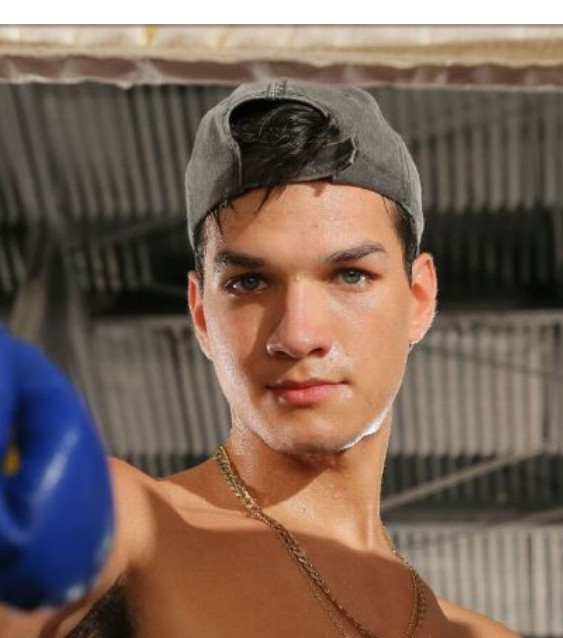
Brandon Figueroa returns to the ring on Saturday after a 14-month absence. He meets Jessie Magdaleno in a 12-round featherweight affair at the T-Mobile Arena in Las Vegas with the winner potentially headed to a match with Japanese superstar Naoya Inoue. Figueroa vs. Magdaleno will be part of the four-fight pay-per-view telecast topped by Canelo Alvarez’s super middleweight title defense against Jaime Munguia.
Akin to Magdaleno, Figueroa (24-1-1, 18 KOs) is a former super bantamweight (122-pound) champion. He won the WBA version of the world title with a 10th-round stoppage of Damien Vazquez and added the WBC belt with a seventh-round KO of previously undefeated Luis Nery who fights Inoue this coming Monday at the “Big Egg” in Tokyo.
Throughout history, many prominent boxers have been identified with the place that hewed them. Students of boxing history can identify the Saginaw Kid, the Terror Haute Terror, the Cincinnati Cobra – the list is long – and even casual fans can name the Brockton Blockbuster, the immortal Rocky Marciano.
Brandon Figueroa hails from Weslaco, a small city in the southern tip of Texas. It is part of the Lower Rio Grande Valley, commonly abbreviated RGV, and the locals feel an emotional tie to the entire valley, a place where the unofficial language among the adult population is Spanglish, a melding of Spanish and English.
Brandon’s older brother Omar Figueroa Jr, who retired in 2022 with a record of 28-3-1 after losing his last three fights, became a local hero after becoming the first boxer from the Valley to win a world title, in his case the WBC lightweight diadem. Brandon, 27, has the opportunity to out-do him by becoming the first boxer from the Valley to win titles in two weight divisions.
The brothers were introduced to boxing by their father, Omar Figueroa Sr. A mailman now in his twenty-seventh year working for the U.S. Postal Service, the elder Figueroa never boxed but followed the sport closely and hoped that one of his sons would follow in the footsteps of his sporting heroes Julio Cesar Chavez and the late Salvador Sanchez. Brandon borrowed a page from the Chavez playbook when he scored his signature win over Luis Nery. A left to the solar plexus ended the match. Nery replied with a sweeping left hook, but it was all instinct. In a delayed reaction, he crumpled to the canvas after launching the errant punch and was counted out.
Although Omar Sr has a picture in his cell phone of Brandon in fighting togs when Brandon was two years old, he insists that he discouraged his younger son from pursuing a career in boxing. “He was too skinny and didn’t have Omar’s natural talent,” the elder Figueroa told this reporter when we chatted at Las Vegas’ Pound4Pound Boxing Gym. “Then, when Brandon was about 12 or 13, he started hurting bigger boys with punches to the body in sparring and I thought, hold on, maybe I have something here.”
Omar Sr. opened a gym, Pantera Boxing, to give his sons a leg up and eventually enough kids from the neighborhood started coming by to field an amateur boxing team.
Omar Figueroa Sr was born in Northern Mexico and came to the United States at age nine. Many of his siblings – he was one of nine children — reside in Mexico but close enough for family get-togethers. The Figueroa family has crossed the international bridge that connects the two countries on many occasions. Returning to Weslaco, they share the span with border-crossers seeking refuge in the United States.
“One of the things I’ve noticed,” says Brandon, “is that there are a lot more Europeans crossing over that bridge into the U.S. than we used to see, especially people from countries like Russia and Ukraine.”
About that nickname: Brandon acquired it while visiting relatives in Rio Bravo, Mexico, situated roughly 18 miles from Weslaco. He was just a boy, perhaps 11 or 12, and it was teenage or pre-teen girls who affixed the “Heartbreaker” label to him. Indeed, in the looks department, he could give Ryan Garcia a run for his money. (Back off, ladies, Brandon has a steady girlfriend.)
Brandon Figueroa doesn’t want boxing to define him. “I’m also a businessman,” he says, noting that he owns several parcels of Weslaco real estate and owns stock in one of his sponsors, LOCK’DIN, a start-up, high-performance beverage company whose Board of Directors includes Manny Pacquiao.
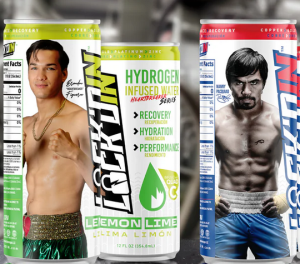
In high school, Brandon took classes in theater. He has a role in a forthcoming Amazon Prime movie, “Find Me,” and a starring role in the first episode of the reconstituted “Tales from the Crypt” which will air on HBO Max.
When Brandon quits boxing, will Hollywood beckon? “I can’t imagine settling down anywhere but in the Valley,” he says. “The Valley will always be a part of me.”
In his last outing, Figueroa won an interim WBC featherweight title with a lopsided decision over Mark Magsayo. In theory, that boosted him into a fight with Rey Vargas who was allowed to keep his WBC featherweight title after moving up to 130 where he suffered his first defeat at the hands of O’Shaquie Foster. But in boxing, “money” trumps “mandatory” and Vargas jumped at the chance to fight in Saudi Arabia where he was fortunate to retain his title when he received a draw in his match with Liverpool’s Nick Ball.
The most lucrative fight out there would be a match with four-belt super bantamweight champion and pound-for-pound king Naoya Inoue who has expressed an interest in moving up to featherweight after disposing of Luis Nery. Yes, that’s putting the cart before the horse, but Brandon Figueroa thinks the challenger from Tijuana, despite his impressive record (35-1-1, 27 KOs) has scant chance of winning. “I found a hole in Nery’s style,” he said, “and knew that once fatigue set in for him, he would be mine.”
Inoue vs. Nery is a very big deal in Japan in part because there’s a hero and a villain. Luis Nery is the only man to defeat the popular Shinsuke Yamanaka, a long-reigning title-holder who quit the sport after Nery knocked him out twice. After their first meeting, Nery’s “A” and “B” samples tested positive for a banned substance and he came in three pounds overweight for the rematch (a substantial edge in a small weight class), for which he was suspended and dropped from the WBC rankings. Nery, wrote TSS correspondent Tamas Pradarics, “repeatedly cheated on the Japanese in ugly and disgusting ways,” and the Japanese haven’t forgotten.
If Brandon Figueroa goes off to Japan some day to oppose Naoya Inoue, it will take some doing to contort him into a villain. “I love the Japanese people and the Japanese culture,” he says, “the whole Samurai thing which is so in tune with the warrior spirit of Mexicans.”
—
The pay-per-view portion of Saturday’s show is available for purchase on various cable and satellite platforms including Prime Video, DAZN.com, and PPV.com. First bell is slated for 8 pm ET/5 pm PT.
Brandon Figueroa vs. Jessie Magdaleno will be the second bout on the four-fight PPV program. It will follow the WBA world welterweight title fight between Eimantas Stanionis and Gabriel Maestre and will precede the WBC interim world welterweight title fight between Mario Barrios and Fabian Maidana.
To comment on this story in the Fight Forum CLICK HERE
Featured Articles
Ramirez Outpoints Barthelemy and Vergil Ortiz Scores Another Fast KO in Fresno
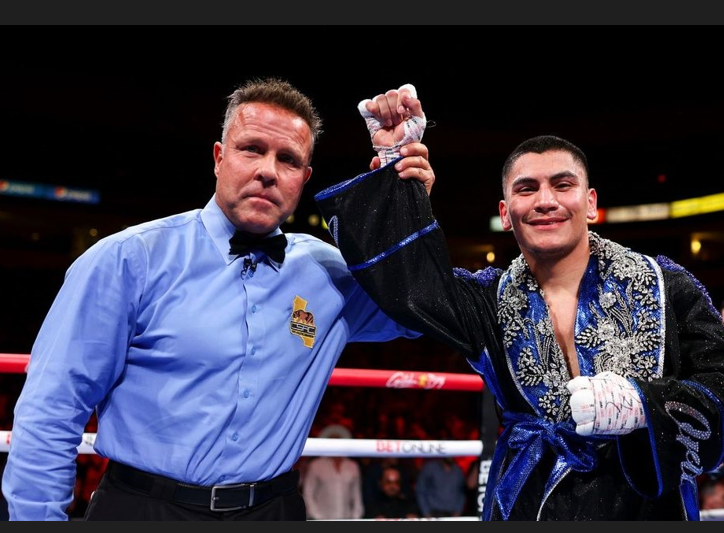
Northern California favorite Jose Ramirez avoided an upset and knockout artist Vergil Ortiz destroyed his opponent on Saturday to set up a showdown with Australia’s power-punching Tim Tszyu.
After a 13-month layoff Ramirez (29-1, 18 KOs) shook off ring rust and avoided an upset by Cuba’s Rances Barthelemy (30-3-1, 15 KOs) in a battle between former world champions at Save Mart Center in Fresno.
It was Ramirez’s first bout under Golden Boy Promotions and he was nearly derailed by the slick counter-punching southpaw in the third and six rounds with laser left counters that connected every time. Though he was floored in the third round it was ruled a push down by referee Jack Reiss.
Fans gasped.
“He throws that left hand and I got hit with it in one round,” Ramirez said. “It motivated him.”
Once Ramirez figured out the remedy, he kept the fight inside and attacked the body and head. Barthelemy was unable to uncork one of his long lefts at close distance.
From the seventh round on the former super lightweight champion took control and kept the Cuban fighter against the ropes and unloaded shots to the body and head. He nearly forced a stoppage in the 11th round.
Barthelemy survived but all three judges scored it big for Ramirez after 12 rounds: 119-109 twice and 118-110.
Vergil KOs Number 21
Knowing a win sets up a massive showdown against Aussie slugger Tim Tszyu, the Texas slugger Vergil Ortiz (21-0, 21 KOs) wasted no time in blasting out Puerto Rico’s Thomas Dulorme (26-7-1, 17 KOs) with a perfectly placed left hook to the body. Dulorme collapsed to the ground in agony.
Referee Tom Taylor stopped counting at 2:39 of the first round.
“It was a very calculated punch,” Ortiz said.
It was a commanding one round performance that sets up the showdown against the equally powerful Tszyu who despite losing a split decision to Sebastian Fundora last month by split decision, retains his reputation as a dangerous puncher.
Ortiz, who has 21 knockouts in 21 fights, will probably be fighting Tszyu in Los Angeles on June 1 if all negotiations go smoothly.
“Tim (Tszyu) I know you are watching the fight,” said Ortiz. “I’m ready. Let’s put on a great performance.”
Other Bouts
Oscar Duarte (27-2-1, 22 KOs) proved his knockout loss against Ryan Garcia would not stop him from improving as he defeated Jojo Diaz (33-6-1) by knockout at 2:32 of the ninth round in a super lightweight match. Referee Michael Margado wisely stopped the bludgeoning as a towel came flying in almost simultaneously.
It was the first time Diaz was ever defeated by knockout, though he never touched the canvas. It was also the first time Duarte trained with Robert Garcia and the difference was notable as he repeatedly walked through incoming fire and attacked the smaller fighter continuously.
“I want to fight the best in the world,” Duarte said.
Female Title Fight
A rematch battle for the flyweight championship saw Argentina’s Gabriela Alaniz (15-1) defeat Marlen Esparza (14-2) this time with a two-fisted attack to win by split decision after 10 rounds.
Esparza failed to make weight and walked in three pounds overweight and Alaniz took advantage to win the WBA, WBC, and WBO flyweight titles in the rematch. Once again the scores were puzzling but this time in favor of Alaniz 97-93, 96-94, and 92-98.
Alaniz now holds the WBO, WBA, WBC flyweight world titles.
Welterweights
Mexico’s Raul Curiel (15-0, 13 KOs) busted body shots on Jorge Marron Jr. (20-5-2) and floored him twice in the first round. The second body blow left Marron paralyzed and unable to continue at 1:31 of the first round as referee Thomas Taylor counted him out.
Curiel, who is managed by Frank Espinoza and son, proved he’s ready for the upper levels of the welterweight division.
“I think I’m ready for the bigger names,” Curiel said. “You see the results.”
Photo credit: Cris Esqueda / Golden Boy
To comment on this story in the Fight Forum CLICK HERE
Featured Articles
Avila Perspective, Chap. 282: Ryan’s Song, Golden Boy in Fresno and More

Avila Perspective, Chap. 282: Ryan’s Song, Golden Boy in Fresno and More
Don’t call it an upset.
Days after Ryan Garcia proved the experts wrong, those same experts are re-tooling their evaluation processes.
It’s mind-boggling to me that 95 percent thought Garcia had no chance. Hear me out.
First, Garcia and Haney fought six times as amateurs with each winning three. But this time with no head gear and smaller gloves, Garcia had to have at least a 50/50 chance of winning. He is faster and a more powerful puncher.
Facts.
Haney is a wonderful boxer with smooth, almost artistic movements. But history has taught us power and speed like Garcia’s can’t be discounted. Think way back to legendary fighters like Willie Pep and Sandy Sadler. All that excellent defensive skill could not prevent Sadler from beating Pep in three of their four meetings.
Power has always been an equalizer against boxing skill.
Ben Lira, one of the wisest and most experienced trainers in Southern California, always professed knockout power was the greatest equalizer in a fight. “You can be behind for nine rounds and one punch can change the outcome,” he said.
Another weird theory spreading before the fight was that Garcia would quit in the fight. That was a puzzling one. Getting stopped by a perfect body shot is not quitting. And that punch came from Gervonta “Tank” Davis who can really crack.
So how did Garcia do it?
In the opening round Ryan Garcia timed Devin Haney’s jab and countered with a snapping left hook that rattled and wobbled the super lightweight champion. After that, Garcia forced Haney to find another game plan.
Garcia and trainer Derrick James must have worked hours on that move.
I must confess that I first saw Garcia’s ability many years ago when he was around 11 or 12. So I do have an advantage regarding his talent. A few things I noticed even back then were his speed and power. Also, that others resented his talent but respected him. He was the guy with everything: talent and looks.
And that brings resentment.
Recently I saw him and his crew rapping a song on social media. Now he’s got a song. Next thing you know Hollywood will be calling and he’ll be in the movies. It’s happened before with fighters such as Art Aragon, the first Golden Boy in the 50s. He was dating movie stars and getting involved with starlets all over Hollywood.
Is history repeating itself or is Garcia creating a new era for boxing?
Since 2016 people claimed he was just a social media creation. Now, after his win over Devin Haney a former undisputed lightweight champion and the WBC super lightweight titleholder, the boxer from the high desert area of Victorville has become one of the highest paid fighters in the world.
Ryan Garcia has entered a new dimension.
Golden Boy Season
After several down years the Los Angeles-based company Golden Boy Promotions suddenly is cracking the whip in 2024.
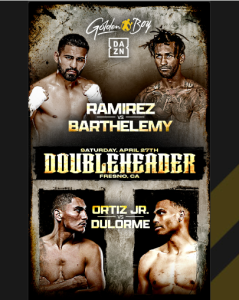
Avila
Vergil Ortiz Jr. (20-0, 20 KOs) returns to the ring and faces Puerto Rico’s Thomas Dulorme (26-6-1, 17 KOs) a welterweight gatekeeper who lost to Jaron “Boots” Ennis and Eimantas Stanionis. They meet as super welterweights in the co-main event at Save Mart Arena in Fresno, Calif. on Saturday, April 27. DAZN will stream the Golden Boy Promotions card live.
It’s a quick return to action for Ortiz who is still adjusting to the new weight division. His last fight three months ago ended in less than one round in Las Vegas. It was cut short by an antsy referee and left Ortiz wanting more after more than a year of inactivity in the prize ring.
Ortiz has all the weapons.
Also, Northern California’s Jose Carlos Ramirez (28-1, 18 KOs) meets Cuba’s Rances Barthelemy (30-2-1, 15 KOs) in a welterweight affair set for 12 rounds.
It’s difficult to believe that former super lightweight titlist Ramirez has been written off by fans after only one loss. That was several years ago against Scotland’s Josh Taylor. One loss does not mean the end of a career.
“My goal is to get back on top and to get all those belts back. I still feel like I am one of the best 140-pounders in the division,” said Ramirez who lives in nearby Avenal, Calif.
An added major attraction features Marlen Esparza in a unification rematch against Gabriela “La Chucky” Alaniz for the WBA, WBC, WBO flyweight titles. Their first fight was
a controversial win by Esparza that saw one judge give her nine of 10 rounds in a very close fight. Those Texas judges.
In a match that could steal the show, Oscar Duarte (26-2-1, 21 KOs) faces former world champion Jojo Diaz (33-5-1, 15 KOs) in a lightweight match.
Munguia and Canelo
Don’t sleep on this match.
Its current Golden Boy fighter Jaime Munguia facing former Golden Boy fighter Saul “Canelo” Alvarez in a battle between Mexico’s greatest sluggers next week at the T-Mobile Arena in Las Vegas on May 4.
“I think Jaime Munguia is going to do something special in the ring,” said Oscar De La Hoya, the CEO for Golden Boy.
Tijuana’s Munguia showed up at the Wild Card Boxing gym in Hollywood where a throng of media from Mexico and the US met him.
Munguia looked confident and happy about his opportunity to fight great Canelo.
“It’s a hard fight,” said Munguia. “Truth is, its big for Mexico and not only for Mexicans but for boxing.”
Fights to Watch
Fri. DAZN 6 p.m. Yoeniz Tellez (7-0) vs Joseph Jackson (19-0).
Sat. DAZN 9:30 a.m. Peter McGrail (8-1) vs Marc Leach (18-3-1); Beatriz Ferreira (4-0) vs Yanina Del Carmen 14-3).
Sat. DAZN 5 p.m. Vergil Ortiz (20-0) vs Thomas Dulorme (26-6-1); Jose Carlos Ramirez (28-1) vs Rances Barthelemy (30-2-1); Marlen Esparza (14-1) vs Gabriela Alaniz (14-1).
Photo credit: Cris Esqueda / Golden Boy Promotions
To comment on this story in the Fight Forum CLICK HERE
-
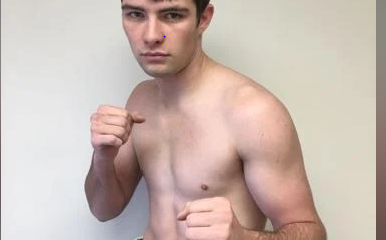
 Featured Articles2 weeks ago
Featured Articles2 weeks agoIn a Massive Upset, Dakota Linger TKOs Kurt Scoby on a Friday Night in Atlanta
-
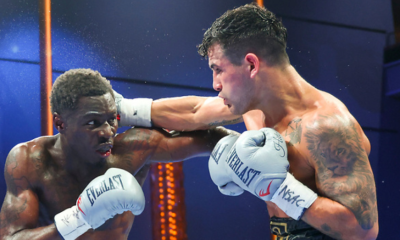
 Featured Articles4 weeks ago
Featured Articles4 weeks agoHitchins Controversially Upends Lemos on a Matchroom Card at the Fontainebleau
-
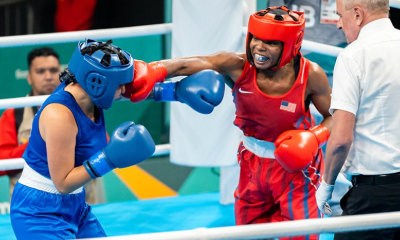
 Featured Articles4 weeks ago
Featured Articles4 weeks agoThe Hauser Report: Literary Notes and More
-

 Featured Articles4 weeks ago
Featured Articles4 weeks agoAvila Perspective, Chap. 280: Oscar Valdez, One of Boxing’s Good Guys, and More
-
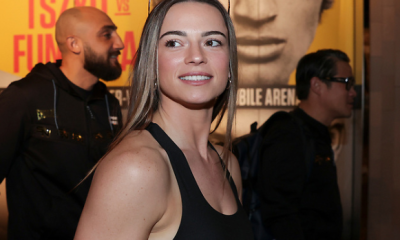
 Featured Articles4 weeks ago
Featured Articles4 weeks agoThe Sky is the Limit for Globetrotting Aussie Featherweight Skye Nicolson
-

 Featured Articles4 weeks ago
Featured Articles4 weeks agoTito Sanchez Defeats Erik Ruiz at Fantasy Springs
-
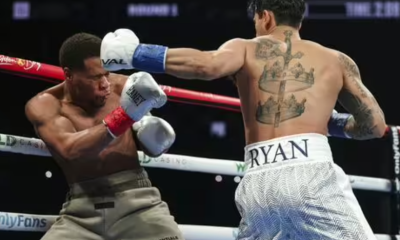
 Featured Articles2 weeks ago
Featured Articles2 weeks agoIn a Shocker, Ryan Garcia Confounds the Experts and Upsets Devin Haney
-
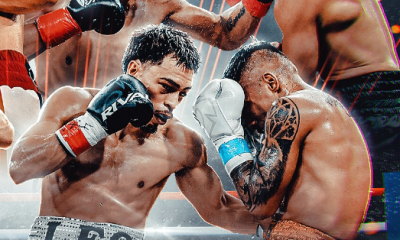
 Featured Articles3 weeks ago
Featured Articles3 weeks agoResurgent Angelo Leo Turns Away Eduardo Baez on a Wednesday Night in Florida

